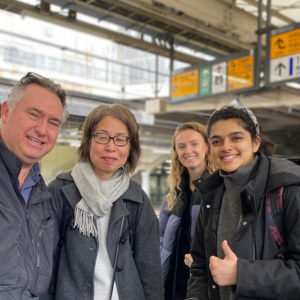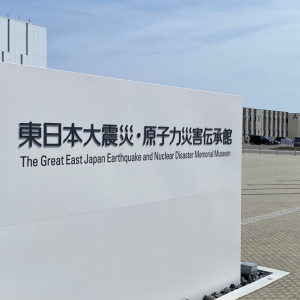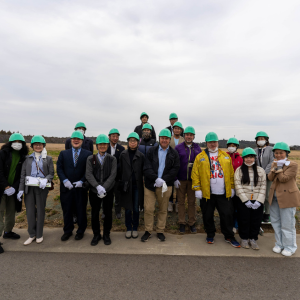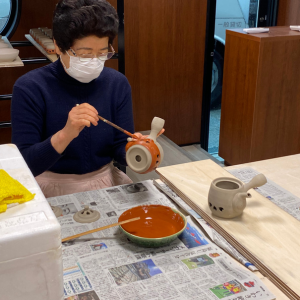News & Updates
Kieran and Mari travel to Japan for The Hope Tourism Hamadori Inbound Project Guided Tour
Friday, 26 April 2024The Hope Tourism Hamadori Inbound Project Guided Tour, Sunday 24th - Tuesday 27th March 2024
Report by Kieran Greenhow, Senior Program Specialist
OBJECTIVE: Uniting in the effort to fight back in the aftermath of the disaster inspires hope and courage in foreign visitors “My image of Fukushima changed from the site of a disaster to the land of hope!”
It has been thirteen years since the Great East Japan Earthquake and nuclear disaster. In the face of this unprecedented disaster, there was a loss of things, people, and time. And yet, here we are today, witnessing many people strive to rebuild towns, revitalize industry, and bring new life to Hamadori. With the support of people in other regions and countries, recovery is rapidly progressing. We are conducting this tour with the goal of revitalizing the Hamadori area through inbound tourism using assessment and tourist resources.
Saturday 23rd March
Flight from Australia to Tokyo Japan (Narita Airport)
We were met at the arrivals area at Narita Airport and caught the train from Narita to Ueno.
We caught the Keisei Skyliner which was a very convenient, cost effective and efficient mode of transportation to get into central Tokyo.
We overnighted at APA Ueno EkiMae.
Sunday 24th March
This morning, we caught the Hitachi 3 Express from Ueno Station to Namie Station
Our first visit was to Ukedo Elementary School.
This set the tone for the entire tour. This area was ground zero for the massive 9.1 undersea megathrust earthquake and resulting 15metre tsunami that devastated the area on March 11, 2011.
It was a very solemn experience to see the damage caused by the tsunami and the incredible story of the Headmaster of the school, after feeling the earthquake, realising the danger the school was in. He quickly gathered all the students and staff and evacuated the school, making a beeline for the nearest hill, approximately 15 minutes on foot, turning away parents that were trying to collect their children, telling them that he was taking responsibility and would meet them on top of the hill once everyone was evacuated. All students and staff survived.
After visiting the elementary school, we visited the Great East Japan Earthquake and Nuclear Disaster Memorial Museum which showed a detailed timeline of the events from when the earthquake, tsunami and nuclear disaster struck to the immediate aftermath, rescue, recovery and clean up.
We also heard the harrowing recollection of a survivor of the events of that fateful day and the months and years following the event. The survivor told of her hectic actions after feeling the earthquake, finding her children, and trying to escape the pending tsunami and then the threat of the radiation leaking from the crippled nuclear power plant over the following days. She told of the mayhem of trying to escape the area among thousands of other evacuees and trying to coordinate with her ex-husband to deliver her children to him so they would be safe. It was a very real, emotional, and touching recollection of events and brings the human side of the events into perspective.
We then visited downtown Futaba; this town was evacuated due to unsafe radiation levels from the damaged Fukushima nuclear power plant. It was deemed safe for habitation in February 2022, and started welcoming back residents. After a decade of being separated from the area, many past residents are reluctant to return due to the awful memories of March 11, and others have just moved on, found new roots in a new area and have decided to stay in their new home. This has left Futaba feeling like a ghost town with less than 10% of the original inhabitants returning. The local community is searching for ways to encourage people to return or start a new life in the area.
The Futaba Art District is one of the ideas to attract young and budding artists to the area and to hopefully attract tourists to view the artwork around the town.
We also visited the Shohatsu Shrine by the Futaba Station, a local gathering point for locals to enjoy festivals and events.
This evening, we stayed at J Village, a purpose-built national soccer training facility.
The J-Village facility is comprised of eight natural grass pitches, including a spectator stadium; two artificial turf pitches; all-weather soccer training grounds; rainy-weather training grounds; a hotel containing two hundred guest rooms; a fitness gym; an arena; and a pool.
Here we had a “nigiri-sushi” making experience, where a qualified chef showed us how to prepare and cut fresh fish for sushi and then roll the rise and place the fish on top to create our own hand made sushi pieces.
We stayed overnight in the accommodation at the facility.
Monday 25th March
After seeing firsthand the destruction of the disaster and the stories of the local people, today was a chance to hear the story from TEPCO, the operators of the Fukushima Daiichi Nuclear Power Station.
We visited TEPCO Decommissioning Archive Centre and the Fukushima Daiichi Nuclear Power Station. Here they went into great detail of what happened during the earthquake, what happened when the tsunami swamped the site and the exact cause of the plant failure that occurred. The company acknowledges their failures and their responsibility to the local people, the Japanese people, and the global community. They are going to great lengths to ensure the decommissioning of the plant is done safely and expediently, with as minimal as possible effects on the surrounding environment.
This was a very interesting experience.
We next visited the Interim Storage Facility, where millions of tonnes of contaminated soil and debris from the areas surrounding the nuclear power plant are being stored in underground storage containers, on land owned by local farmers that have provided the land to the power plant until it is safe to move. The total area of the planned site is approx. 16 km2.
It is expected to stay in this “interim” storage facility until it is slated for permanent disposal within 30 years of the commencement of the interim storage. It is yet to be decided where the waste will be disposed of after the time expires.
This was a very interesting experience and should be included in any visit.
In the afternoon we visited the Nexus Farm Okuma which was a welcome fun and enjoyable relief to the serious nature of the preceding elements of the tour. At Nexus Farm Okuma visitors can learn about how food (in this case strawberries) can be grown safely and successfully in this environment. The owner of the facility explained in great detail the preparation, growing, harvesting and shipping of the strawberries to retail outlets throughout Japan. At the end of the tour the participants were all given a small plate and condensed milk and invited to pick and eat as many strawberries as possible. The strawberries were very large, sweet, and delicious and was certainly a highlight of the trip.
This evening, we stayed at Hotel Hiten, a seaside Ryokan with an outdoor onsen (natural hot spring bath).
Tuesday 26th March
Today we visited Tomioka Wine Domaine. This is a new start up business with an ambition to start a winery in the area where traditionally grapes have not been grown. The owner of the property searched the world to find a suitable type of grape that would thrive in the local conditions, and they expect to have their first harvest in 2025. The project is one of many to help encourage people to move back to the area by providing employment and tourism opportunities.
Our next stop was at Obori Soma Ware Kichiro Kiln, a traditional pottery company that has a very long history, said to have originated at the beginning of the Edo period (1603-1868).
Obori-soma ware (called Obori-soma yaki in Japanese) is a form of porcelain produced around the town of Namie in Fukushima prefecture. This craft uses blue porcelain enamel which is made from locally collected grindstone. The distinctive feature of Obori-soma ware is its pattern of blue fissures. On a glassy surface of celadon porcelain glaze, these blue cracks cover the entire piece. A difference in the shrinkage rate between the raw materials and enamel causes cracks to occur when baking. At that time, a beautiful cracking sound can be heard. Then, pictures that depict the sacred horses revered by the former Soma domain (located in eastern Fukushima prefecture) are hand-drawn on the pottery. The craft is double-fired, so the inner layer of Obori-soma ware insulates hot liquids for a long time, while the outer shell prevents anyone from burning their hands. This double-firing technique is not seen in any other type of porcelain and is performed with user-friendliness of the product in mind.
In the afternoon we attended the FONT workshop at Futaba Business Incubation and Community Center. FONT (Futaba, Okuma, Namie, and Tomioka) were affected by the Great East Japan Earthquake and nuclear disaster and were forced to evacuate due to air radiation. The workshop focused on the past, present, and future of the town, inviting FONT town residents to share with participants how the town has been rebuilt and the importance of community revitalization/formation.
We overnighted at Futabaya Ryokan; a traditional inn located in Futaba town.
Futabaya Ryokan reopened for business in July 2016 after the March 11 disaster. Today, the inn is visited by tourists and others interested in the history and reconstruction of the area. Recently, the inn provides lodging for students from the University of Tokyo, agricultural students from Turkey, and young entrepreneurs who are moving to the area.
Wednesday 27th March
After breakfast our Famil tour concluded, and we caught the train back to Tokyo.
In the afternoon I visited the Ikebukuro Lefe Safety Learning Centre, where you can learn how to respond to various emergency situations such as fire, flood, and earthquakes, through VR headsets and hands on experiences. There is an earthquake simulator where you can experience up to magnitude 7 earthquake.
Thursday, 28th March
I visited Odaiba on this day, an island built on reclaimed land in Tokyo Bay. It is accessible by a driverless train from Shinbashi Station and by subway from Osaki Station.
Places I visited included Miraikan (Science Museum), DiverCity and DECKS shopping centres which house the Unicorn Gundam, Joypolis indoor theme park and Tokyo Trick Art Museum.
Other places of interest on Odaiba are Small World’s Tokyo, TeamLab Planets, Toyosu Fish Market and Tokyo Rinkai Disaster Prevention Park.




